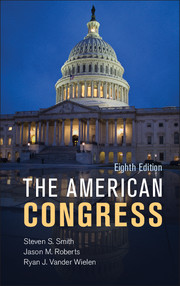Book contents
- Frontmatter
- Contents
- PREFACE
- Acknowledgments
- 1 The Troubled Congress
- 2 Representation and Lawmaking in Congress
- 3 Congressional Elections and Policy Alignments
- 4 Members, Goals, Resources, and Strategies
- 5 Parties and Leaders
- 6 The Standing Committees
- 7 The Rules of the Legislative Game
- 8 The Floor and Voting
- 9 Congress and the President
- 10 Congress and the Courts
- 11 Congress, Lobbyists, and Interest Groups
- 12 Congress and Budget Politics
- Appendix Introduction to the Spatial Theory of Legislating
- Index
- References
11 - Congress, Lobbyists, and Interest Groups
- Frontmatter
- Contents
- PREFACE
- Acknowledgments
- 1 The Troubled Congress
- 2 Representation and Lawmaking in Congress
- 3 Congressional Elections and Policy Alignments
- 4 Members, Goals, Resources, and Strategies
- 5 Parties and Leaders
- 6 The Standing Committees
- 7 The Rules of the Legislative Game
- 8 The Floor and Voting
- 9 Congress and the President
- 10 Congress and the Courts
- 11 Congress, Lobbyists, and Interest Groups
- 12 Congress and Budget Politics
- Appendix Introduction to the Spatial Theory of Legislating
- Index
- References
Summary
The first amendment to the constitution provides that Congress may make no law abridging the right of the people to petition the government for a redress of grievances. Court rulings interpret the amendment broadly to include organized and paid representatives of the people, thereby limiting Congress’s ability to regulate lobbying. In practice, interest groups and their lobbyists are a very important means by which the public conveys their expectations and demands to Congress. Nevertheless, Americans believe that members of Congress are beholden to special interests and lobbyists. A November 2012 survey conducted by the Center on Congress at Indiana University found that 67 percent of Americans believe that Congress neither listens nor cares about what ordinary citizens think; more than 81 percent of those surveyed gave Congress a D or F on its ability to control the influence of special interests. In fact, when asked what they thought was the main influence on members of Congress, respondents were more than five times more likely to answer special interests than constituents. A 2010 CBS/The New York Times survey found that 80 percent of Americans agreed that most members of Congress are more interested in serving special interest groups than the people they represent.
These contrasting views – that lobbyists are essential to democracy and yet reviled by the public – give interest groups and lobbyists an uneasy place in congressional politics. In Chapter 1, we noted that representation of organized interests is a rapidly growing industry in Washington. In this chapter, we reemphasize this theme, discuss the evolving strategies of interest groups, and review the limited efforts of Congress to regulate lobbying. Congress, in accordance with the Constitution, has been able to put in place only minimal regulations on lobbying. As an alternative, Congress has placed more severe restrictions on legislators, as it is allowed to do, with respect to their relations with organized interests. Restrictions on campaign contributions from organized interests were detailed in Chapter 3. In this chapter, we concentrate on developments in the legislative strategies of groups and lobbyists.
- Type
- Chapter
- Information
- The American Congress , pp. 345 - 374Publisher: Cambridge University PressPrint publication year: 2013



